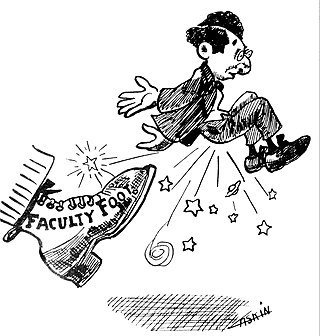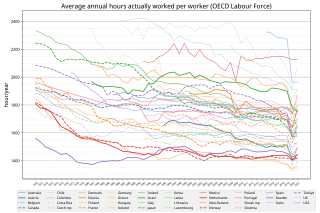Related Research Articles

Temporary work or temporary employment refers to an employment situation where the working arrangement is limited to a certain period of time-based on the needs of the employing organization. Temporary employees are sometimes called "contractual", "seasonal", "interim", "casual staff", "outsourcing", and "freelance"; or the words may be shortened to "temps". In some instances, temporary, highly skilled professionals refer to themselves as consultants. Increasingly, executive-level positions are also filled with interim executives or fractional executives.
The labour law concept of leave, specifically paid leave or, in some countries' long-form, a leave of absence, is an authorised prolonged absence from work, for any reason authorised by the workplace. When people "take leave" in this way, they are usually taking days off from their work that have been pre-approved by their employer in their contracts of employment. Labour laws normally mandate that these paid-leave days be compensated at either 100% of normal pay, or at a very high percentage of normal days' pay, such as 75% or 80%. A furlough is a type of leave.
Flextime, also spelled flex-time or flexitime (BE), is a flexible hours schedule that allows workers to alter their workday and adjust their start and finish times. In contrast to traditional work arrangements that require employees to work a standard 9 a.m. to 5 p.m. day, Flextime typically involves a "core" period of the day during which employees are required to be at work, and a "bandwidth" period within which all required hours must be worked. The working day outside of the core period is "flexible time", in which employees can choose when they work, subject to achieving total daily, weekly or monthly hours within the bandwidth period set by employers, and subject to the necessary work being done. The total working time required of employees on an approved Flextime schedule is much the same as those who work under traditional work schedule regimes.
Self-employment is the state of working for oneself rather than an employer. Tax authorities will generally view a person as self-employed if the person chooses to be recognised as such or if the person is generating income for which a tax return needs to be filed. In the real world, the critical issue for tax authorities is not whether a person is engaged in business activity but whether the activity is profitable and therefore potentially taxable. In other words, the trading is likely to be ignored if there is no profit, so occasional and hobby- or enthusiast-based economic activity is generally ignored by tax authorities. Self-employed people are usually classified as a sole proprietor, independent contractor, or as a member of a partnership.

Termination of employment or separation of employment is an employee's departure from a job and the end of an employee's duration with an employer. Termination may be voluntary on the employee's part (resignation), or it may be at the hands of the employer, often in the form of dismissal (firing) or a layoff. Dismissal or firing is usually thought to be the employee's fault, whereas a layoff is generally done for business reasons outside the employee's performance.

Parental leave, or family leave, is an employee benefit available in almost all countries. The term "parental leave" may include maternity, paternity, and adoption leave; or may be used distinctively from "maternity leave" and "paternity leave" to describe separate family leave available to either parent to care for their own children. In some countries and jurisdictions, "family leave" also includes leave provided to care for ill family members. Often, the minimum benefits and eligibility requirements are stipulated by law.

The Family and Medical Leave Act of 1993 (FMLA) is a United States labor law requiring covered employers to provide employees with job-protected, unpaid leave for qualified medical and family reasons. The FMLA was a major part of President Bill Clinton's first-term domestic agenda, and he signed it into law on February 5, 1993. The FMLA is administered by the Wage and Hour Division of the United States Department of Labor.
Pregnancy discrimination is a type of employment discrimination that occurs when expectant women are fired, not hired, or otherwise discriminated against due to their pregnancy or intention to become pregnant. Common forms of pregnancy discrimination include not being hired due to visible pregnancy or likelihood of becoming pregnant, being fired after informing an employer of one's pregnancy, being fired after maternity leave, and receiving a pay dock due to pregnancy. Pregnancy discrimination may also take the form of denying reasonable accommodations to workers based on pregnancy, childbirth, and related medical conditions. Pregnancy discrimination has also been examined to have an indirect relationship with the decline of a mother's physical and mental health. Convention on the Elimination of All Forms of Discrimination against Women prohibits dismissal on the grounds of maternity or pregnancy and ensures right to maternity leave or comparable social benefits. The Maternity Protection Convention C 183 proclaims adequate protection for pregnancy as well. Though women have some protection in the United States because of the Pregnancy Discrimination Act of 1978, it has not completely curbed the incidence of pregnancy discrimination. The Equal Rights Amendment could ensure more robust sex equality ensuring that women and men could both work and have children at the same time.
An employee handbook, sometimes also known as an employee manual, staff handbook, or company policy manual, is a book given to employees by an employer.
California's Paid Family Leave (PFL) insurance program, which is also known as the Family Temporary Disability Insurance (FTDI) program, is a law enacted in 2002 that extends unemployment disability compensation to cover individuals who take time off work to care for a seriously ill family member or bond with a new minor child. If eligible, you can receive benefit payments for up to eight weeks. Payments are about 60 to 70 percent of your weekly wages earned 5 to 18 months before your claim start date. You will receive payments by debit card or check. Benefits equal approximately 70% of earnings and have a maximum per week, for a total of up to six weeks.

Employee engagement is a fundamental concept in the effort to understand and describe, both qualitatively and quantitatively, the nature of the relationship between an organization and its employees. An "engaged employee" is defined as one who is fully absorbed by and enthusiastic about their work and so takes positive action to further the organization's reputation and interests. An engaged employee has a positive attitude towards the organization and its values. In contrast, a disengaged employee may range from someone doing the bare minimum at work, up to an employee who is actively damaging the company's work output and reputation.
Sick leave is paid time off from work that workers can use to stay home to address their health needs without losing pay. It differs from paid vacation time or time off work to deal with personal matters, because sick leave is intended for health-related purposes. Sick leave can include a mental health day and taking time away from work to go to a scheduled doctor's appointment. Some policies also allow paid sick time to be used to care for sick family members, or to address health and safety needs related to domestic violence or sexual assault. Menstrual leave is another type of time off work for a health-related reason, but it is not always paid.
Paid time off, planned time off, or personal time off (PTO), is a policy in some employee handbooks that provides a bank of hours in which the employer pools sick days, vacation days, and personal days that allows employees to use as the need or desire arises. This policy pertains mainly to the United States, where there are no federal legal requirements for a minimum number of paid vacation days. Instead, U.S. companies determine the amount of paid time off that will be allotted to employees, while keeping in mind the payoff in recruiting and retaining employees.

The Wage and Hour Division (WHD) of the United States Department of Labor is the federal office responsible for enforcing federal labor laws. The Division was formed with the enactment of the Fair Labor Standards Act of 1938. The Wage and Hour mission is to promote and achieve compliance with labor standards to protect and enhance the welfare of the Nation's workforce. WHD protects over 144 million workers in more than 9.8 million establishments throughout the United States and its territories. The Wage and Hour Division enforces over 13 laws, most notably the Fair Labor Standards Act and the Family Medical Leave Act. In FY18, WHD recovered $304,000,000 in back wages for over 240,000 workers and followed up FY19, with a record-breaking $322,000,000 for over 300,000 workers.

Work–life balance in the United States is having enough time for work and enough time to have a personal life in the United States. Related, though broader, terms include lifestyle balance and life balance. The most important thing in work and life is the personal ability to demonstrate and meet the needs of work and personal life in order to achieve goals. People should learn to deal with role engagement management, role conflict management and managing life needs to achieve balance. Balance is about how to properly achieve the desired work and life satisfaction and needs in a conflict situation.
The motherhood penalty refers to the economic disadvantages women face in the workplace as a result of becoming mothers. This sociological concept highlights how working mothers often experience wage reductions, diminished perceived competence, and fewer career advancement opportunities compared to their childless counterparts. Studies indicate that mothers face a per-child wage penalty that exacerbates the gender pay gap. In addition to lower pay, mothers are often viewed as less committed and less dependable employees, leading to hiring biases, lower job evaluations, and reduced chances for promotion. These penalties are not limited to a single cause but are rooted in societal perceptions, workplace biases, and theories like the work-effort model, which posits that caregiving responsibilities reduce mothers' work productivity. The motherhood penalty is prevalent across various industrialized nations and has been documented across racial and economic lines, with women of color and those in low-wage jobs experiencing more severe consequences. Despite increased attention to this issue, the penalty has not shown significant signs of decline.

Parental leave is regulated in the United States by US labor law and state law. The Family and Medical Leave Act of 1993 (FMLA) requires 12 weeks of unpaid leave annually for parents of newborn or newly adopted children if they work for a company with 50 or more employees. As of October 1, 2020, the same policy has been extended to caregivers of sick family members, or a partner in direct relation to the birth of the child therefore responsible for the care of the mother. Although 12 weeks are allowed to them, on average American fathers only take 10 days off, due to financial need. Beginning in 2020, California, New Jersey, and Rhode Island required paid parental leave to employees, including those a part of 50 or less employees. There is no paid paternity leave in the United States currently.
Joint employment is the sharing of control and supervision of an employee's activity among two or more business entities.
The Organisation for Economic Co-operation and Development provides data about OECD countries related to paid parental leave length, average pay rate and full-rate equivalent. Not all countries provide mothers with a pay rate equal to what they would have received if the absence had not occurred.
Absence management, also known as leave management, is a combination of employer policies, procedures, or programs designed to handle employee leaves of absence and minimize the impact of those absences on the employer. Absence management programs aim to maximize productivity by supporting an employee from initial absence through return-to-work and stay-at-work plans.
References
- ↑ "Sample Attendance Policy" (PDF). Employers.org. Retrieved 2014-04-08.
- ↑ "Attendance Policy #1". Society for Human Resource Management. Retrieved 2014-04-08.
- ↑ Jon Hyman (2012-09-18). "No Call, No Show, No FMLA". Workforce. Retrieved 2014-04-08.
- ↑ Michael Winerip (2009-04-17). "They Feel Your Losses". New York Times . Retrieved 2014-04-08.